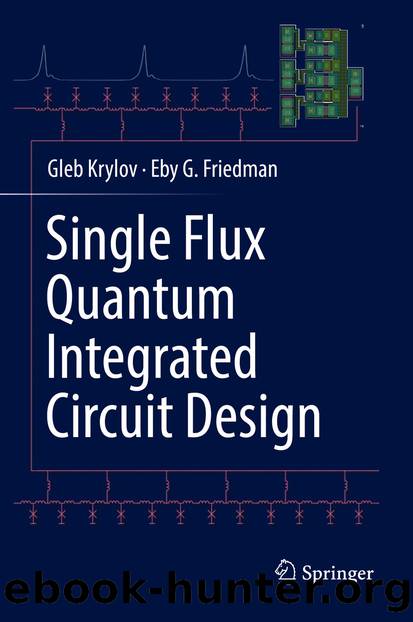Single Flux Quantum Integrated Circuit Design by Gleb Krylov & Eby G. Friedman

Author:Gleb Krylov & Eby G. Friedman
Language: eng
Format: epub
ISBN: 9783030768850
Publisher: Springer International Publishing
8.3 Model Verification
The proposed model has been integrated into an existing RCSJ Verilog-A model of a Josephson junction [266], evaluated within the Cadence Spectre simulator, and compared with experimental data reported in [88]. The I-V characteristics resulting from a DC analysis are shown in Fig. 8.2.
Fig. 8.2 I câââV i characteristic of the proposed model. The experimental data are shown as circles
From the DC analysis, the model accurately captures the behavior of the device. The input parameters of the proposed model are the device geometry, gain, threshold voltage, and critical current without injection. The gain and threshold voltage are estimated by the model or manually adjusted based on available experimentally measured parameters. The simulation accurately describes the I-V characteristics of existing devices [85, 88, 340] with a mean absolute error of 7.4%.
To date, no experimental transient measurements of SFT devices exist in the literature. A model characterizing the transient behavior has therefore not been compared to experimental data. This model, however, can be compared to the expected behavior of a Josephson junction with the critical current modulated by the injection current. A simulation of this behavior is depicted in Fig. 8.3. In this transient simulation, the acceptor junction of the model is connected to the bias current source and biased at I bâ=â0.7ââ âI c [50]. This current is insufficient to switch the acceptor junction into a resistive state. The injector current I i, initially zero, gradually increases to 1.4 mA, corresponding to an injector voltage of 5 mV. After the injector voltage is applied, the acceptor junction continuously switches, generating a series of SFQ pulses. This switching behavior is due to suppression of the acceptor critical current to approximately 66% of the original critical current. After the injector voltage is reduced, the acceptor critical current is restored to the current level without injection, terminating the switching process (see Fig. 8.3d). A simulation of this behavior accurately captures the expected transient behavior of the device and confirms the application of the proposed SFT model to the SFQ circuit design and analysis process.
Fig. 8.3Transient response of an SFT device based on the proposed model, (a) critical current of the acceptor, (b) phase of the acceptor, (c) injector voltage, and (d) acceptor voltage
Download
This site does not store any files on its server. We only index and link to content provided by other sites. Please contact the content providers to delete copyright contents if any and email us, we'll remove relevant links or contents immediately.
| Circuits | Digital Design |
| Electric Machinery & Motors | Electronics |
| Fiber Optics | Networks |
| Superconductivity |
Whiskies Galore by Ian Buxton(41941)
Introduction to Aircraft Design (Cambridge Aerospace Series) by John P. Fielding(33095)
Small Unmanned Fixed-wing Aircraft Design by Andrew J. Keane Andras Sobester James P. Scanlan & András Sóbester & James P. Scanlan(32767)
Craft Beer for the Homebrewer by Michael Agnew(18200)
Turbulence by E. J. Noyes(7983)
The Complete Stick Figure Physics Tutorials by Allen Sarah(7339)
Kaplan MCAT General Chemistry Review by Kaplan(6903)
The Thirst by Nesbo Jo(6882)
Bad Blood by John Carreyrou(6585)
Modelling of Convective Heat and Mass Transfer in Rotating Flows by Igor V. Shevchuk(6408)
Learning SQL by Alan Beaulieu(6239)
Weapons of Math Destruction by Cathy O'Neil(6220)
Man-made Catastrophes and Risk Information Concealment by Dmitry Chernov & Didier Sornette(5958)
Digital Minimalism by Cal Newport;(5707)
Life 3.0: Being Human in the Age of Artificial Intelligence by Tegmark Max(5520)
iGen by Jean M. Twenge(5387)
Secrets of Antigravity Propulsion: Tesla, UFOs, and Classified Aerospace Technology by Ph.D. Paul A. Laviolette(5336)
Design of Trajectory Optimization Approach for Space Maneuver Vehicle Skip Entry Problems by Runqi Chai & Al Savvaris & Antonios Tsourdos & Senchun Chai(5040)
Pale Blue Dot by Carl Sagan(4960)
